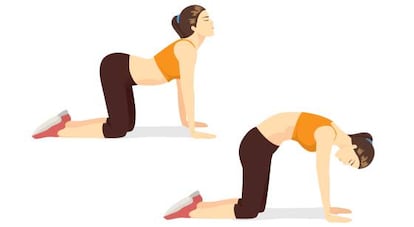How to protect your physical health while working from home during Spain’s coronavirus lockdown
Poor posture and spending too much time seated can lead to problems in the cervical and lumbar areas, but these can be avoided with stretches and exercise

In a bid to stop the spread of the coronavirus, many businesses in Spain have asked workers to telecommute, following the recommendations from the Health Ministry. For those who are now telecommuting, we have already provided tips on how to work productively from home, but it is also important to understand how to take care of your physical health and use exercise to prevent atrophy and muscle discomfort.
People who spend long hours in front of the computer, regardless of whether they are at home or work, are at a higher risk of certain problems. Miguel Soro, the vice-president of the Galician Physiotherapy Association, says that the most common ailments occur in “the cervical area and lumbar area,” although the lower body also suffers from spending so much time seated.
As well as avoiding going to the fridge every five minutes and forcing yourself to change out of your pajamas, people who work from home should also perform a series of physical routines to prevent future ailments. The World Health Organization (WHO) recommends that adults between 18 and 64 years old spend at least 150 minutes a week doing moderate physical activity. In that case, practicing these activities for 20 minutes a day should help you stay in shape.
First: where to sit
In the office, the work environment encourages behavior that is not as easy to maintain in private. The intimacy of the home can mean that we sit in postures that are less upright, and this can be harmful in the long term. Montserrat Ruiz-Olivares, the secretary general of the Madrid Physiotherapy Association, argues that “it is better [for your body] to be seated than lying down.” But, she adds, “it’s better to be standing than seated, it’s better to be moving than standing still, and it’s better to do more exercise than less.”
The idea that the physiotherapist is trying to get across is that, more than having the correct posture, the key to preventing muscular pain is movement. One option that Ruiz-Olivares suggests is to work seated on a fitball – a large exercise ball that is often used in pilates – instead of an office chair. “In the office, this can look bad, but not at home. If you sit on a fitball it will ensure that you move, and it will mean that you are not slumped in the seat,” she says.
Posture changes and breaks
Ruiz-Olivares maintains that “there is no perfect posture, the best posture is to change it.” This is backed by Soro, who explains that, for years, scientific research has not focused on maintaining one, correct posture since “everyone has [different] physiological curves.” For this reason, recommendations now center on “the need to move and exercise after work.”
Ruiz-Olivares says the key is to stop working at least every hour to take a walk and allow the body to stretch and change position. Soro believes this should be done “every 15 or 20 minutes.” But he adds: “If their work doesn’t allow them to get up so often, they should at the very least stand up and take a couple steps.”
Exercises during breaks
“If you go to the bathroom, you can do some pushups, stretch a little and sit back down,” says Ruiz-Olivares. This is an example of a simple exercise that can be done during these breaks.
“If people have stairs at home, they can go up and down them so as to not lose strength in their legs,” she adds. And if you don’t have stairs? That is not a problem; the same effect can be achieved with a few squats.
Soro also says that some exercises can be performed while seated, such as stretching. But, the specialist explains, “the important thing is physical activity, this is what will prevent injuries from sitting for too long. Stretches are more pain relievers.”
Stretches for the end of the day
With work done and the workday finished, these stretches can be expanded to more extensive exercises on the floor. For an example, you can stretch your back with the following exercises.

More exercises to do at home
In addition to the lower back and upper body, the lower limbs are also going to be stiff from sitting for so long. “Because we limit our movement, the lower limbs lose muscle mass,” explains Ruiz-Olivares. “That’s why you should do a series of exercises such as strides.”
The physiotherapist emphasizes the need to counteract “everything that occurs when you don’t walk all day.” To do this, she recommends using an exercise bike or treadmill if you have one at home.
English version by Nell Snow.
Tu suscripción se está usando en otro dispositivo
¿Quieres añadir otro usuario a tu suscripción?
Si continúas leyendo en este dispositivo, no se podrá leer en el otro.
FlechaTu suscripción se está usando en otro dispositivo y solo puedes acceder a EL PAÍS desde un dispositivo a la vez.
Si quieres compartir tu cuenta, cambia tu suscripción a la modalidad Premium, así podrás añadir otro usuario. Cada uno accederá con su propia cuenta de email, lo que os permitirá personalizar vuestra experiencia en EL PAÍS.
¿Tienes una suscripción de empresa? Accede aquí para contratar más cuentas.
En el caso de no saber quién está usando tu cuenta, te recomendamos cambiar tu contraseña aquí.
Si decides continuar compartiendo tu cuenta, este mensaje se mostrará en tu dispositivo y en el de la otra persona que está usando tu cuenta de forma indefinida, afectando a tu experiencia de lectura. Puedes consultar aquí los términos y condiciones de la suscripción digital.
More information
Últimas noticias
James Cameron: ‘For the films I like to make to continue to exist, we have to find a way to make them cheaper’
Families demand repatriation of bodies of Colombians who died in Ukraine: ‘This war is a slaughterhouse for foreigners’
The guardians of the meteorites of the Argentine Chaco
Helen Levitt, the photographer who captured the theater of the everyday
Most viewed
- Christian Louboutin: ‘Young people don’t want to be like their parents. And if their parents wear sneakers, they’re going to look for something else’
- US sanctions against jailed cartel leader ‘El Marro’ highlight Mexico’s lack of control over its prisons
- Cartels in Mexico take a leap forward with narco-drones: ‘It is criminal groups that are leading the innovation race’
- Liset Menéndez de la Prida, neuroscientist: ‘It’s not normal to constantly seek pleasure; it’s important to be bored, to be calm’
- ‘El Limones’ and the growing union disguise of Mexican organized crime









































